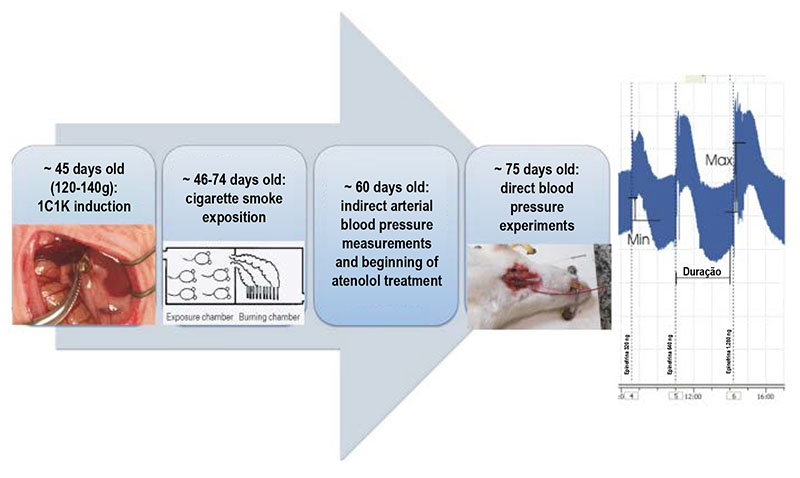Volume 114, Nº 2, February 2020
DOI: https://doi.org/10.36660/abc.20180433
ORIGINAL ARTICLE
Passive Cigarette Smoking Impact on Blood Pressure Response to Epinephrine and Felypressin in 1K1C Hypertensive Rats Treated or not with Atenolol
Camila A. Fleury
Elizandra P. M. Almeida
Thiago J. Dionisio
Adriana M. Calvo
Gabriela M. Oliveira
Sandra L. Amaral
Carlos F. Santos
Flávio A. C. Faria

Figure 1 – Schematic study protocol: at 45 days of life, the rats were submitted to clip implantation (1K1C hypertension induction); on the next day, the smoker groups were exposed to cigarette smoke; at 60 days of life, blood pressure was measured by indirect means and atenolol treatment was started; approximately at 75 days of life, direct blood pressure experiments were performed. An example of pulsatile recording after epinephrine administration details how parameters were calculated.
Abstract
Background: Cigarette smoking is usually associated with hypertension and may modify vasoconstrictor response.
Objective: The present study aimed to analyze and compare the interaction of passive cigarette smoking and hypertension on epinephrine and felypressin blood pressure effects after intravascular injection.
Method: 45-day male Wistar rats had the main left renal artery partially constricted and the right kidney removed (1K1C model). Rats were placed in the chamber for exposition to passive cigarette smoking (10 cigarettes) during 10 min (6 days a week). Hypertensive rats received atenolol (90 mg/kg/day) by gavage for two weeks. Hypotensive and hypertensive response, response duration and heart rate were recorded from direct blood pressure values. The significance level was 5%.
Results: Passive cigarette smoking increased maximal hypertensive response to epinephrine in normotensive and 1K1Catenolol treated rats and to felypressin only in 1K1C-atenolol treated rats; it also reduced epinephrine hypotensive response. Epinephrine increased heart rate in normotensive and hypertensive passive smokers or non-smoker rats. Comparing the two vasoconstrictors, epinephrine showed greater hypertensive response in normotensive smokers, 1K1C-atenolol treated smokers and non-smokers. However, in normotensive-nonsmoker rats, felypressin showed a greater and longer hypertensive effect.
Conclusions: Our results suggest that passive cigarette smoking may reduce epinephrine vasodilation and increase hypertensive response when compared to felypressin. Therefore, felypressin may be safe for hypertensive patients to avoid tachycardia and atenolol interaction, but for normotensive and non-smoker patients, epinephrine may be safer than felypressin. (Arq Bras Cardiol. 2020; 114(2):295-303)
Keywords: Tobacco Use Disorder; Hypertension; Rats; Felypressin; Atenolol; Epinephrine; Tobacco Smoke Pollution; Nicotine/adverse effects.















